Evaluation of All-for-One Tourism in Mountain Areas Using Multi-Source Data
Abstract
1. Introduction
2. Data and Methods
2.1. Research Region
2.2. Basic Data
- Digital Elevation Model (DEM). DEM data used in this study is SRTM data (Shuttle Radar Topography Mission, NASA-NGA, USA). SRTM successfully generates the most complete high-resolution digital topographic database of the Earth, covering over 80% of the Earth’s land surface between 60° north and 56° south latitude with data points posted every 1 arc-second (approximately 30 m). The elevation models are arranged into tiles, each covering one degree of latitude and one degree of longitude. The raw data can be obtained from the website: http://srtm.csi.cgiar.org/SELECTION/inputCoord.asp. Figure 1 shows the elevation of Zunyi, which ranges from 240 to 2124 m.
- NCEP/NCAR Global Reanalysis Products. It is a continually updated globally gridded data set that represents the state of the Earth’s atmosphere, incorporating observations and numerical weather prediction (NWP) model output from 1948 to present. It is a joint product from the National Centers for Environmental Prediction (NCEP) and the National Center for Atmospheric Research (NCAR). Its monthly mean datasets are used in our study, including monthly mean air temperature, monthly mean of relative humidity and monthly surface wind speed. Their spatial resolution is about 2.5°. The data can be obtained at: ftp://ftp.cdc.noaa.gov/pub/Datasets/ncep.reanalysis.derived/surface/.
- Geospatial Data Cloud. It provides MODIS synthetic products in China. The datasets used in this paper includes China 1 KM land surface temperature (LST) monthly synthetic products (MODLT1M) and China 500 M normalized difference vegetation index (NDVI) monthly synthetic products (MODND1M). MODLT1M is the monthly average value of MODLT1T daily products while MODND1M is the maximum value of MODND1D daily products within a month. The data set is provided by International Scientific & Technical Data Mirror Site, Computer Network Information Center, Chinese Academy of Sciences. Registered users can freely obtain data from the website: http://www.gscloud.cn.
- SPOT-NDVI Data. The SPOT VGT-S NDVI data at 1 km spatial resolution can be obtained from http://www.spot-vegetation.com/. The VGT-S NDVI product is the synthesized NDVI for a 10-day period. The 10-day periods were defined as the 1st to 10th, the 11th to the 20th and the 21st to the end of each month. Thus, there are three NDVI images for each month. The monthly composite DNVI images were derived from corresponding three 10-day NDVI products through calculating their maximum value. The VGT-S product has been pre-processed for geometric, radiometric and atmospheric corrections. Therefore, no further pre-processing of the SPOT VGT-S product is needed for practical application.
- TRMM 3B43 Data. The Tropical Rainfall Measuring Mission (TRMM) was launched in November 1997 as a joint project by NASA and the Japanese Space Agency (JAXA). The mission uses five instruments: Precipitation Radar (PR), TRMM Microwave Imager (TMI), Visible Infrared Scanner (VIRS), Clouds & Earths Radiant Energy System (CERES) and Lightning Imaging Sensor (LSI). The TRMM Multi-satellite Precipitation Analysis (TMPA) was designed to combine all available precipitation datasets from different satellite sensors and monthly surface rain gauge data to provide estimation of precipitation at spatial resolution of 0.25°. One of TMPA products is the TRMM 3B43 monthly data, covering 50° N to 50° S for 1998–present. The latest Version 7 was available to public in May 2012 and can be obtained freely from http://mirador.gsfc.nasa.gov.
- In-situ Ground Meteorological Data. US National Climate Data Center is the world’s largest provider of meteorological and climatic data. Its land-based observations are collected from instruments sited at locations on every continent. They include temperature, dew point, relative humidity, precipitation, wind speed and direction, visibility, atmospheric pressure, and types of weather occurrences. Data on sub-hourly, hourly, daily, monthly, annual, and multiyear timescales are available. All used stations are displayed in Figure 1. The related datasets are free on website: ftp://ftp.ncdc.noaa.gov/pub/data/gsod.
- POI Data. A point of interest (POI) is a specific location that someone may find useful or interesting. In this study, related POIs include unitary tourism resource points, traffic facilities, hotels or homestays, hospitals or casualty stations, restaurants or farmsteads. These POIs are very important for assessment of tourism resources and social service, and for understanding tourist behavior and satisfaction. Many map service companies, such as Google (https://cloud.google.com/maps-platform/), Baidu (http://lbsyun.baidu.com/), Amap (https://lbs.amap.com/) etc., support location-based services, and POIs can be obtained from their map open platforms through keyword retrieval.
2.3. Downscaling Method
3. Results and Discussion
3.1. Tourism Resources
3.1.1. Abundance and Quality
3.1.2. Spatial Characteristics
3.2. Natural Conditions
3.2.1. Climate Comfort
3.2.2. Evaluation of Disaster Risk
3.3. Social Service
4. Summary
Author Contributions
Funding
Conflicts of Interest
References
- Navío-Marco, J.; Ruiz-Gómez, L.M.; Sevilla-Sevilla, C. Progress in information technology and tourism management: 30 years on and 20 years after the internet-Revisiting Buhalis & Law’s landmark study about eTourism. Tour. Manag. 2018, 69, 460–470. [Google Scholar]
- Sheng, Y.; Ming-Ying, L.A.; Sheng, Z.T. The supply-side structural reform based on all-for-one tourism in minority areas. Reform Econ. Syst. 2015, 5, 11–17. [Google Scholar]
- Wang, L.E.; He, L.; Cheng, S.K.; Min, Q.W. Driving force and development strategies of agro-tourism in china. Chin. J. Eco-Agric. 2012, 20, 681–687. [Google Scholar] [CrossRef]
- Jiang, J.; Liu, H.; Tan, M. Research on the Science and Technology Innovation Path of Tourism Structural Transformation and Upgrading: As an Example of Guangdong Province. J. Chongqing Univ. 2014, 20, 16–24. [Google Scholar]
- Feng, X. All-for-one tourism: The transformation and upgrading direction of regional tourism industry. J. Soc. Sci. Res. 2017, 11, 2374–2378. [Google Scholar] [CrossRef]
- Tölkes, C. Sustainability communication in tourism—A literature review. Tour. Manag. Perspect. 2018, 27, 10–21. [Google Scholar] [CrossRef]
- Li, X.J.; Zhang, L.Y.; Cui, L. Comprehensive tourism: Idea innovation on building a world-class tourism destination. Hum. Geogr. 2013, 3, 130–134. [Google Scholar]
- Li, J.Z. The All-for-One Tourism Is Promising. Available online: http://www.xinhuanet.com/travel/2016-02/09/c_128710701.htm (accessed on 5 November 2018).
- Zhang, H.; Yue, Y. The rational thinking about all-for-one tourism. Tour. Trib. 2016, 31, 15–17. [Google Scholar]
- Cooper, C.P.; Fletcher, J.E.; Gilbert, D.C.; Wanhill, S. Tourism: Principles and Practice; Pitman Publishing: New York, NY, USA, 2013. [Google Scholar]
- Wang, G.H. On the Path and Methods of the Strategic Implementation of All-for-one Tourism. J. Beijing Union Univ. 2017, 15, 12–18. [Google Scholar]
- Potschin, M.B.; Haines-Young, R.H. Improving the quality of environmental assessments using the concept of natural capital: A case study from southern Germany. Landsc. Urban Plan. 2003, 63, 93–108. [Google Scholar] [CrossRef]
- Yi, G.; Hu, E. Advancing and Retreating of Tourist Attractions under the Background of All-for-one Tourism. Chin. Anc. City 2018, 6, 19–24. [Google Scholar]
- Zhang, Q. Research on tourist attractions performance promoting method based on the SWOT analysis method. Ieri Procedia 2012, 1, 254–260. [Google Scholar] [CrossRef]
- Zhu, H.; Liu, J.M.; Tao, H.; Zhang, J. Evaluation and spatial analysis of tourism resources attraction in Beijing based on the internet information. J. Nat. Resour. 2015, 30, 2081–2094. [Google Scholar]
- Yang, X.; Pan, B.; Evans, J.A.; Lv, B. Forecasting Chinese tourist volume with search engine data. Tour. Manag. 2015, 46, 386–397. [Google Scholar] [CrossRef]
- Li, X.; Pan, B.; Law, R.; Huang, X. Forecasting tourism demand with composite search index. Tour. Manag. 2017, 59, 57–66. [Google Scholar] [CrossRef]
- Xiang, Z.; Schwartz, Z.; Gerdes, J.H.J.; Uysal, M. What can big data and text analytics tell us about hotel guest experience and satisfaction? Int. J. Hospit. Manag. 2015, 44, 120–130. [Google Scholar] [CrossRef]
- Long, M.X.; Sun, G.N.; Li-Jun, M.A. Evaluation on tourism climate comfort of Zunyi to develop the red tourism and leisure destination: The comparative analysis of the five red tourism cities. Econ. Geogr. 2011, 31, 701–704. [Google Scholar]
- Ling, W. Analysis on Tourism Climate Comfort Degree of Chishui. J. Anhui Agric. Sci. 2010, 38, 14651–14654. [Google Scholar]
- Zhang, Q.; Zhao, Y. Research on Exploitation of the Red Travel in Zunyi. Econ. Res. Guid. 2007, 2, 134–136. [Google Scholar]
- DeFreitas, C.R.; Scott, D.; Mcboyle, G. A second generation climate index for tourism (CIT): Specification and verification. Int. J. Biometeorol. 2008, 52, 399–407. [Google Scholar] [CrossRef] [PubMed]
- Huffman, G.J.; Adler, R.F.; Bolvin, D.T.; Nelkin, E.J. The TRMM Multisatellite Precipitation Analysis (TMPA): Quasi-Global, Multiyear, Combined-Sensor Precipitation Estimates at Fine Scales. J. Hydrometeorol. 2007, 8, 38. [Google Scholar] [CrossRef]
- Aghakouchak, A.; Mehran, A.; Norouzi, H.; Behrangi, A. Systematic and random error components in satellite precipitation data sets. Geophys. Res. Lett. 2012, 39, 9406. [Google Scholar] [CrossRef]
- Smith, W.L.; Woolf, H.M.; Jacob, W.J. A regression method for obtaining real-time temperature and geopotential height profiles from satellite spectrometer measurements and its application to nimbus 3 “sirs” observations. Mon. Weather Rev. 2013, 98, 582. [Google Scholar] [CrossRef]
- Li, Z.L.; Tang, B.H.; Wu, H.; Ren, H.; Yan, G.; Wan, Z.; Trigo, I.F.; Sobrino, J.A. Satellite-derived land surface temperature: Current status and perspectives. Remote Sens. Environ. 2013, 131, 14–37. [Google Scholar] [CrossRef]
- Ratnam, M.V.; Basha, G.; Murthy, B.V.K.; Jayaraman, A. Relative humidity distribution from SAPHIR experiment on board Megha-Tropiques satellite mission: Comparison with global radiosonde and other satellite and reanalysis data sets. J. Geophys. Res. Atmos. 2013, 118, 9622–9630. [Google Scholar] [CrossRef]
- Brogniez, H.; Fallourd, R.; Mallet, C.; Sivira, R.; Dufour, C. Estimating confidence intervals around relative humidity profiles from satellite observations: Application to the SAPHIR sounder. J. Atmos. Ocean. Technol. 2016, 33, 1005–1022. [Google Scholar] [CrossRef]
- Immerzeel, W.W.; Rutten, M.M.; Droogers, P. Spatial downscaling of TRMM precipitation using vegetative response on the Iberian Peninsula. Remote Sens. Environ. 2009, 113, 362–370. [Google Scholar] [CrossRef]
- Jing, W.; Yang, Y.; Yue, X.; Zhao, X. A spatial downscaling algorithm for satellite-based precipitation over the Tibetan plateau based on NDVI, DEM, and land surface temperature. Remote Sens. 2016, 8, 655. [Google Scholar] [CrossRef]
- Duan, Z.; Bastiaanssen, W.G.M. First results from version 7 TRMM 3B43 precipitation product in combination with a new downscaling-calibration procedure. Remote Sens. Environ. 2013, 131, 1–13. [Google Scholar] [CrossRef]
- Shi, Y.L.; Song, L. Calibration of TRMM 3B43 over Tibetan plateau during 1998–2012. Arid Land Geogr. 2015, 38, 900–911. [Google Scholar]
- General Administration of Quality Supervision, Inspection and Quarantine of the People’s Republic of China (CN-GB). Classification, Investigation and Evaluation of Tourism Resources (GB/T 18972-2017). Available online: http://www.cssn.net.cn/ (accessed on 19 October 2018).
- Wang, L.; Liu, J.M.; Wang, L.E.; Zhu, H.; Lin, J. Tourism resource assessment and spatial analysis of wine tourism development: A case study of the eastern foothills of china’s Helan mountains. J. Mt. Sci. 2018, 15, 645–656. [Google Scholar] [CrossRef]
- Huang, Z.F.; Zhu, Y.; Yuan, L.W.; Xiao-Hai, H.U.; Cao, F.D. The intention, classification and evaluation of leisure tourism resources: A case study of Changzhou, Jiangsu province. Geogr. Res. 2011, 30, 1543–1553. [Google Scholar]
- Richards, G. Cultural tourism: A review of recent research and trends. J. Hospit. Tour. Manag. 2018, 36, 12–21. [Google Scholar] [CrossRef]
- Liu, R.; Wei-Ping, H.U.; Wang, H.L.; Chi, W.U.; Jin, H.E. The road network evolution of Guangzhou-Foshan metropolitan area based on kernel density estimation. Sci. Geogr. Sin. 2011, 30, 81–86. [Google Scholar]
- How Kernel Density Works. Available online: http://pro.arcgis.com/en/pro-app/tool-reference/spatial-analyst/how-kernel-density-works.htm (accessed on 28 September 2018).
- Bigano, A.; Hamilton, J.M.; Tol, R.S.J. The impact of climate on holiday destination choice. Clim. Chang. 2006, 76, 389–406. [Google Scholar] [CrossRef]
- Gössling, S.; Hall, M.C. Tourism and Global Environmental Change: Ecological, Economic, Social and Political Interrelationships. Geogr. Res. 2007, 45, 203–204. [Google Scholar]
- Maddison, D.; Maddison, D. In search of warmer climates: The impact of climate change on flows of British tourists. Clim. Chang. 2001, 49, 193–208. [Google Scholar] [CrossRef]
- Gonzalez, R.R.; Nishi, Y.; Gagge, A.P. Experimental evaluation of standard effective temperature: A new biometeorological index of man’s thermal discomfort. Int. J. Biometeorol. 1974, 18, 1–15. [Google Scholar] [CrossRef] [PubMed]
- Terjung, W.H. Physiological climates of the conterminous us: A bioclimatic classification based on man. Ann. Assn. Am. Geogr. 1966, 56, 141–179. [Google Scholar] [CrossRef]
- Kyle, W. The human bioclimate of Hong Kong. In Proceedings of the Contemporary Climatology Conference, Masaryk University, Brno, Czech, 15–20 August 1994. [Google Scholar]
- Sun, M.S.; Li, S. Empirical indices evaluating climate comfortableness: Review and prospect. Tour. Trib. 2015, 30, 19–34. [Google Scholar]
- Fang, Y. Adaptation Management of Mountain Tourism Service: The Case of the Source Regions of the Yangtze and Yellow River. J. Mt. Sci. 2009, 6, 299–310. [Google Scholar] [CrossRef]
- Grillakis, M.G.; Koutroulis, A.G.; Seiradakis, K.D.; Tsanis, I.K. Implications of 2 °C global warming in European summer tourism. Clim. Serv. 2016, 1, 30–38. [Google Scholar] [CrossRef]
- Liu, Y.; Jin, Y. A Summary of Industry Development on Summer Tourism. Ecol. Econ. 2010, 6, 114–123. [Google Scholar]
- Mountain, Forum. International NGO Consultation on the Mountain Agenda: Summary Report and Recommendations to the United Nations Commission on Sustainable Development; Mountain Institute: Franklin, WV, USA, 1995. [Google Scholar]
- Beedie, P.; Hudson, S. Emergence of mountain-based adventure tourism. Ann. Tour. Res. 2003, 30, 625–643. [Google Scholar] [CrossRef]
- Chen, X.; Pei, Z.; Wang, F. GIS-based assessment of rainstorm-induced geological hazards risk in Enshi autonomous prefecture. J. Geo-Inf. Sci. 2016, 18, 343–352. [Google Scholar]
- Jenks, G.F. The data model concept in statistical mapping. Int. Yearbook Cartogr. 1967, 7, 186–190. [Google Scholar]
- Robert, M.M. In memoriam: George f. Jenks (1916–1996). Am. Cartogr. 1997, 24, 56–59. [Google Scholar]
- Saaty, T.L. Relative measurement and its generalization in decision making: Why pairwise comparisons are central in mathematics for the measurement of intangible factors the analytic hierarchy/network process. Revista de la Real Academia de Ciencias Exactas, Fisicas y Naturales. Serie A. Matematicas 2008, 2, 215–318. [Google Scholar] [CrossRef]
- Tang, C.; Wu, X.; Zheng, Q.; Ning, L. Ecological Security Evaluations of the Tourism Industry in Ecological Conservation Development Areas: A case study of Beijing’s ECDA. J. Clean. Prod. 2018, 999–1010. [Google Scholar] [CrossRef]
- Kapera, I. Sustainable tourism development efforts by local governments in Poland. Sustain. Cities Soc. 2018, 40, 581–588. [Google Scholar] [CrossRef]
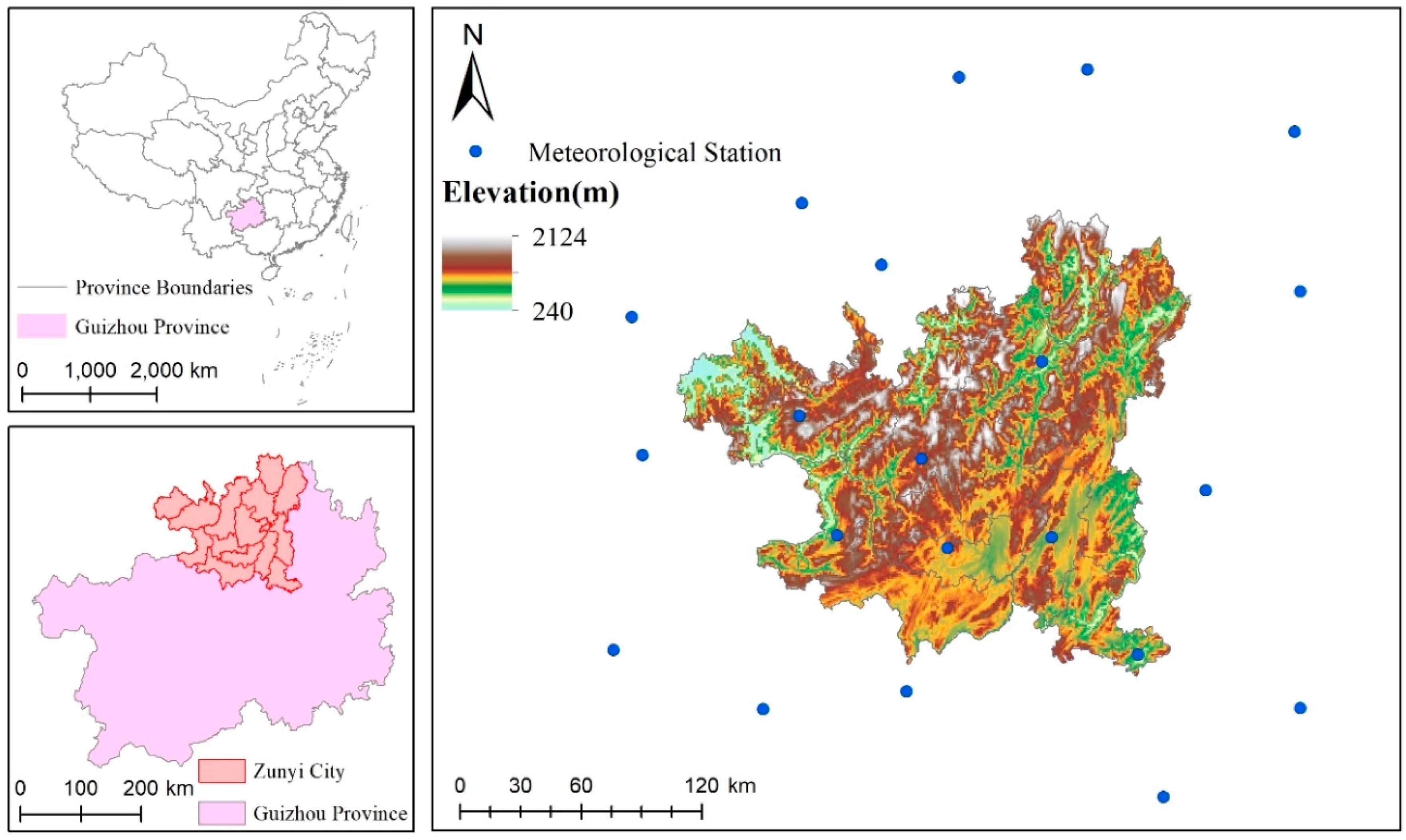

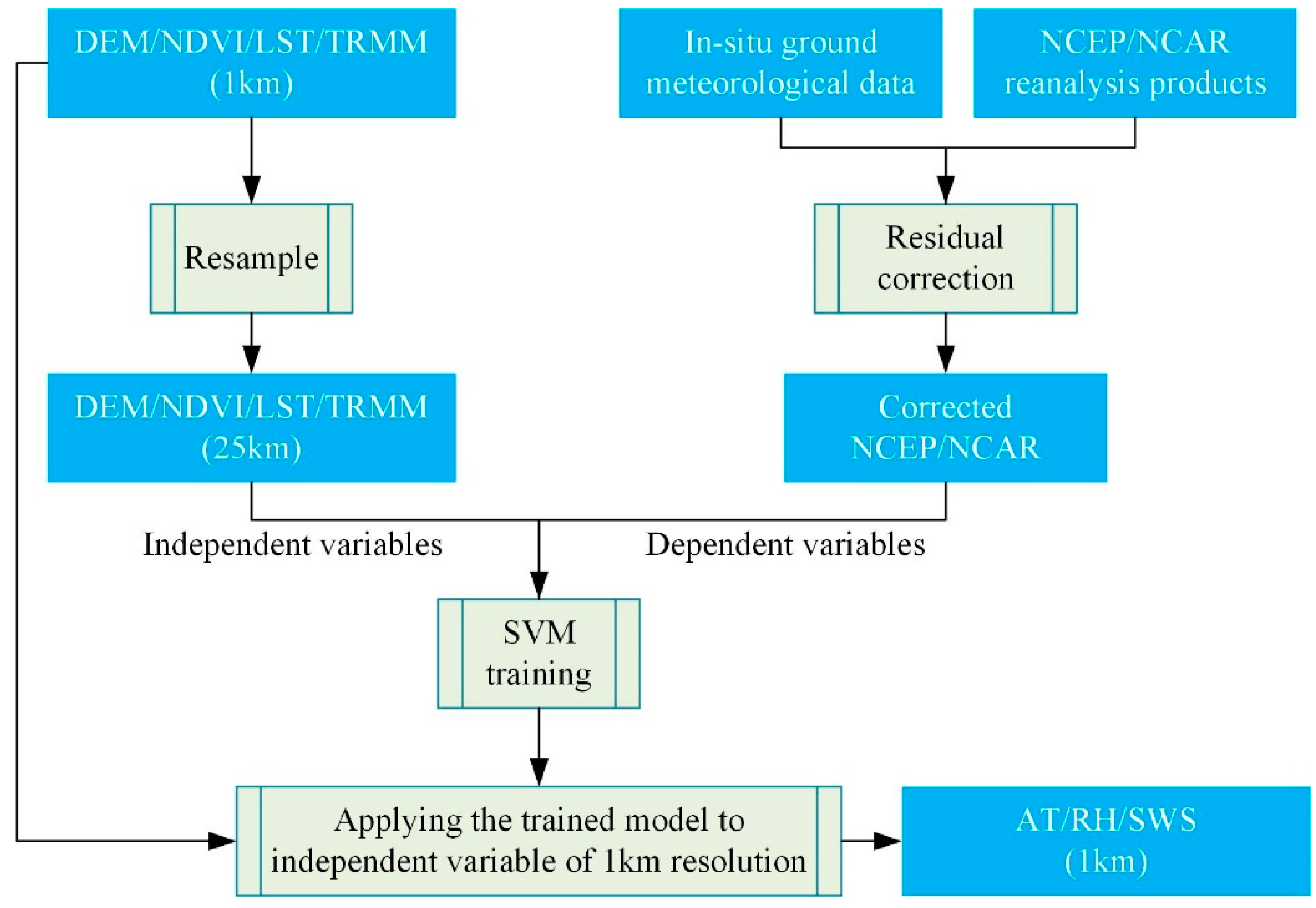
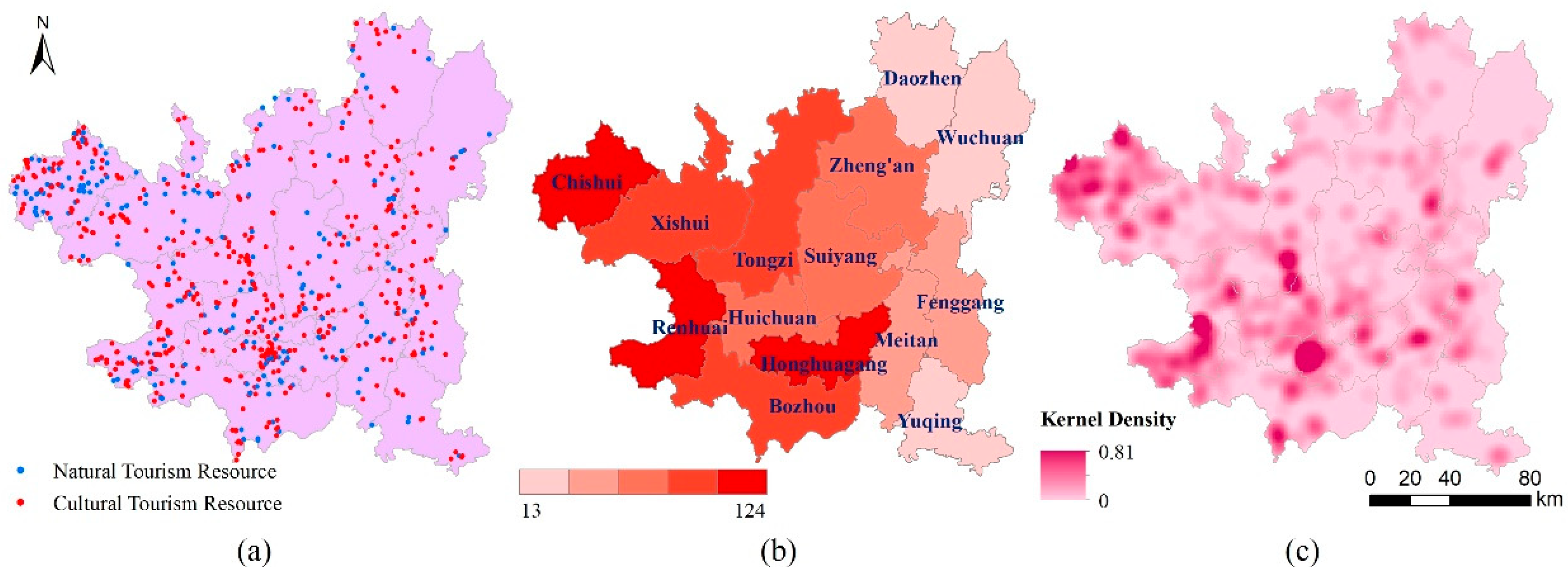
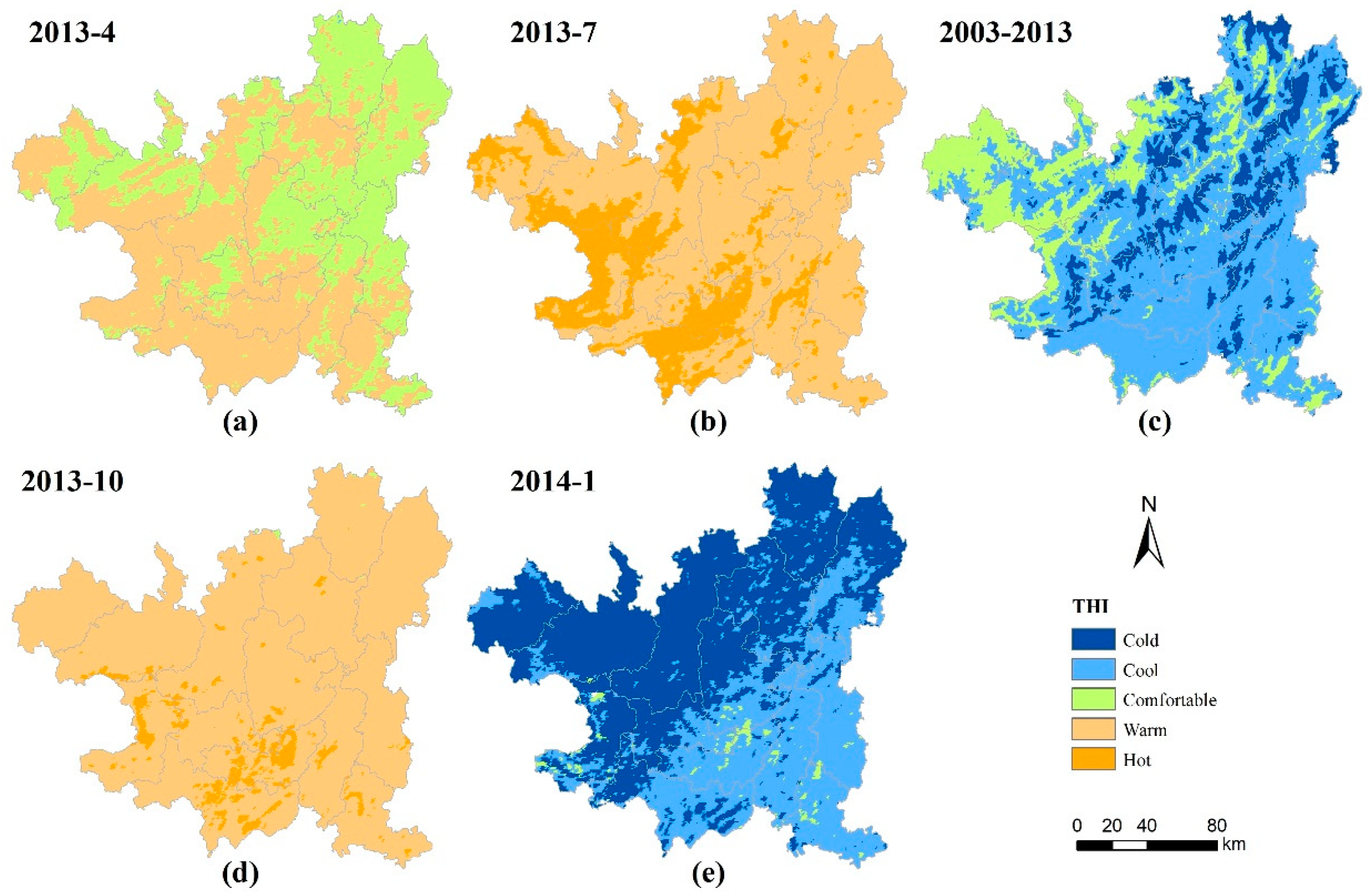
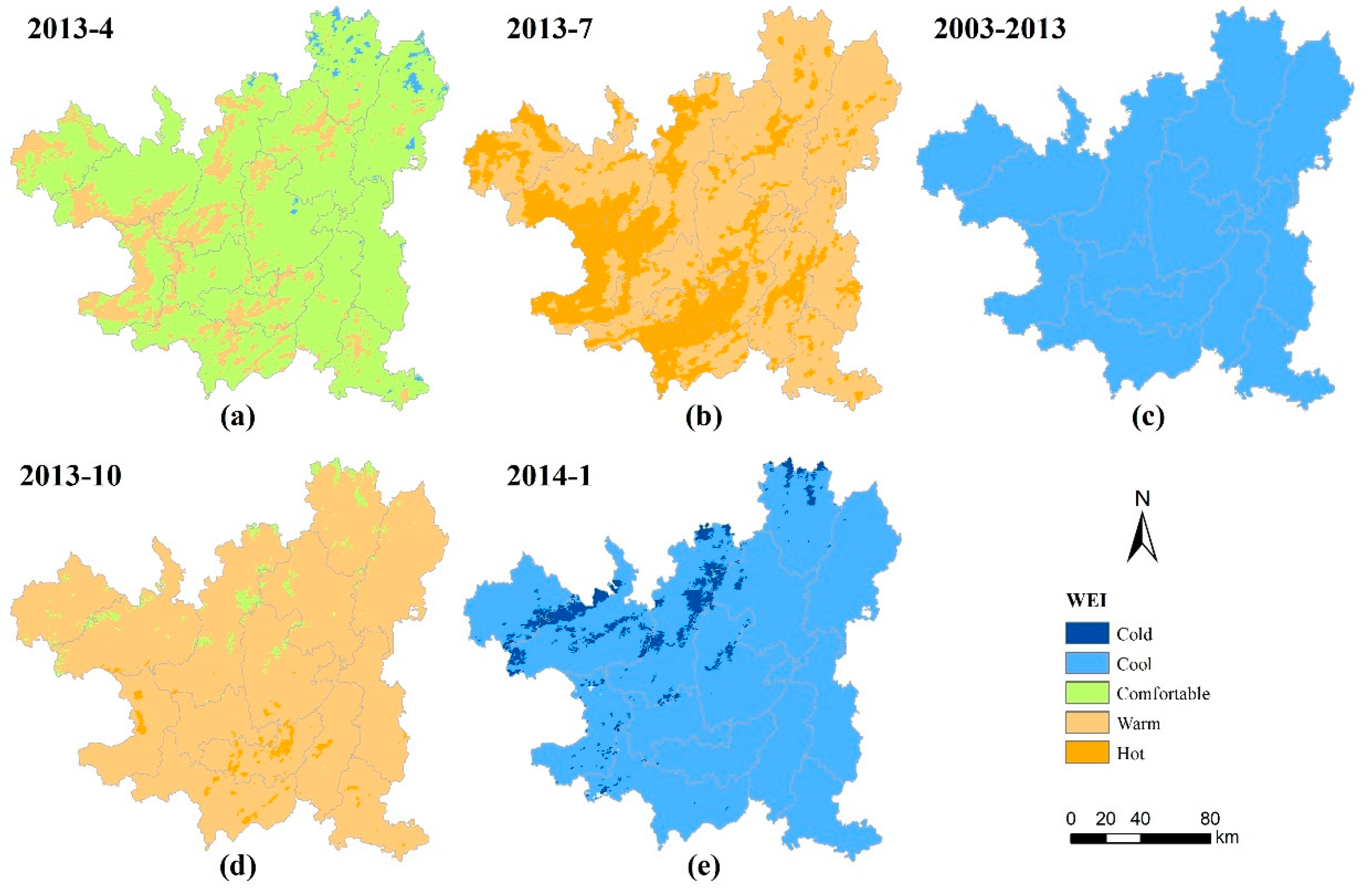
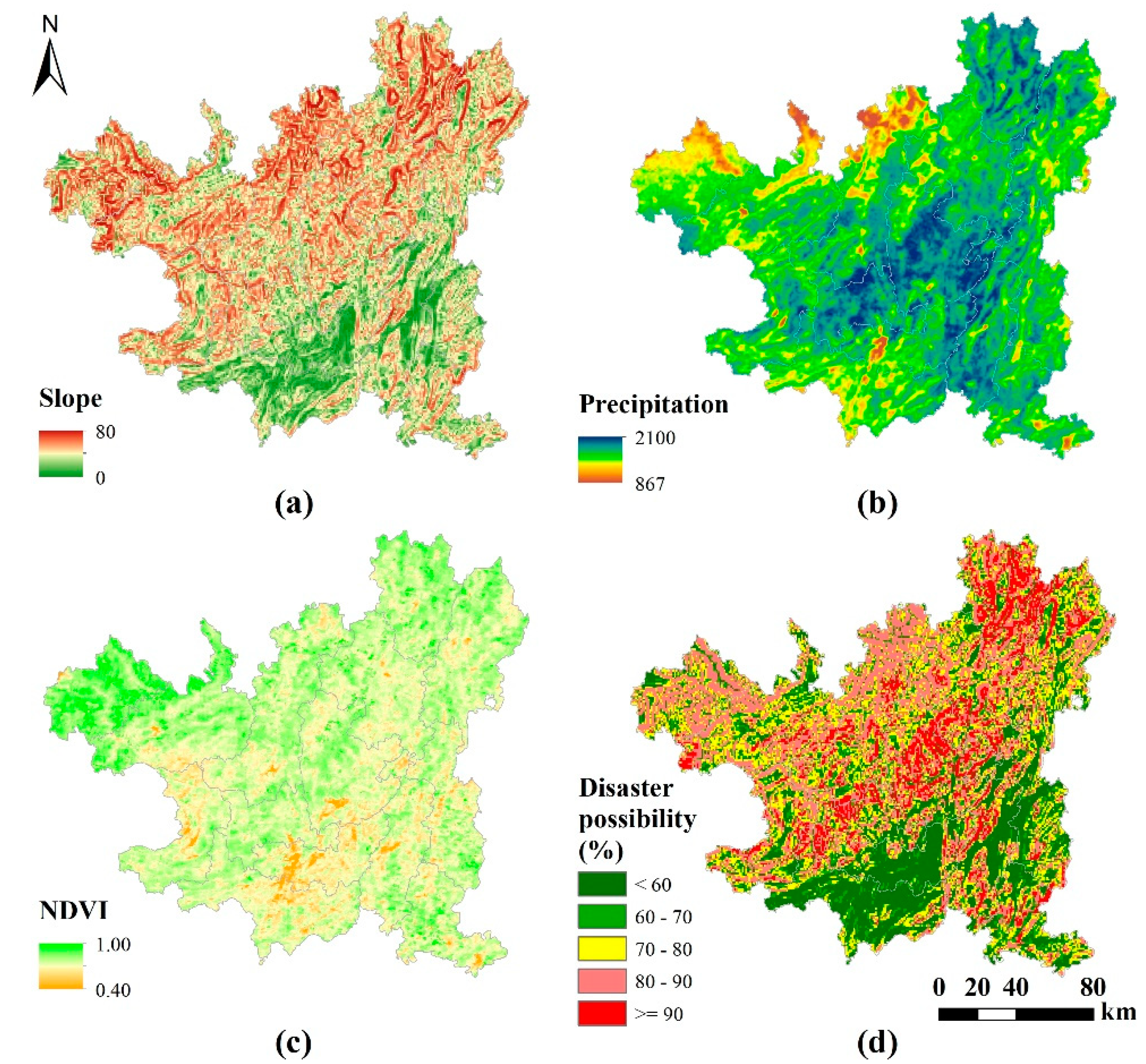
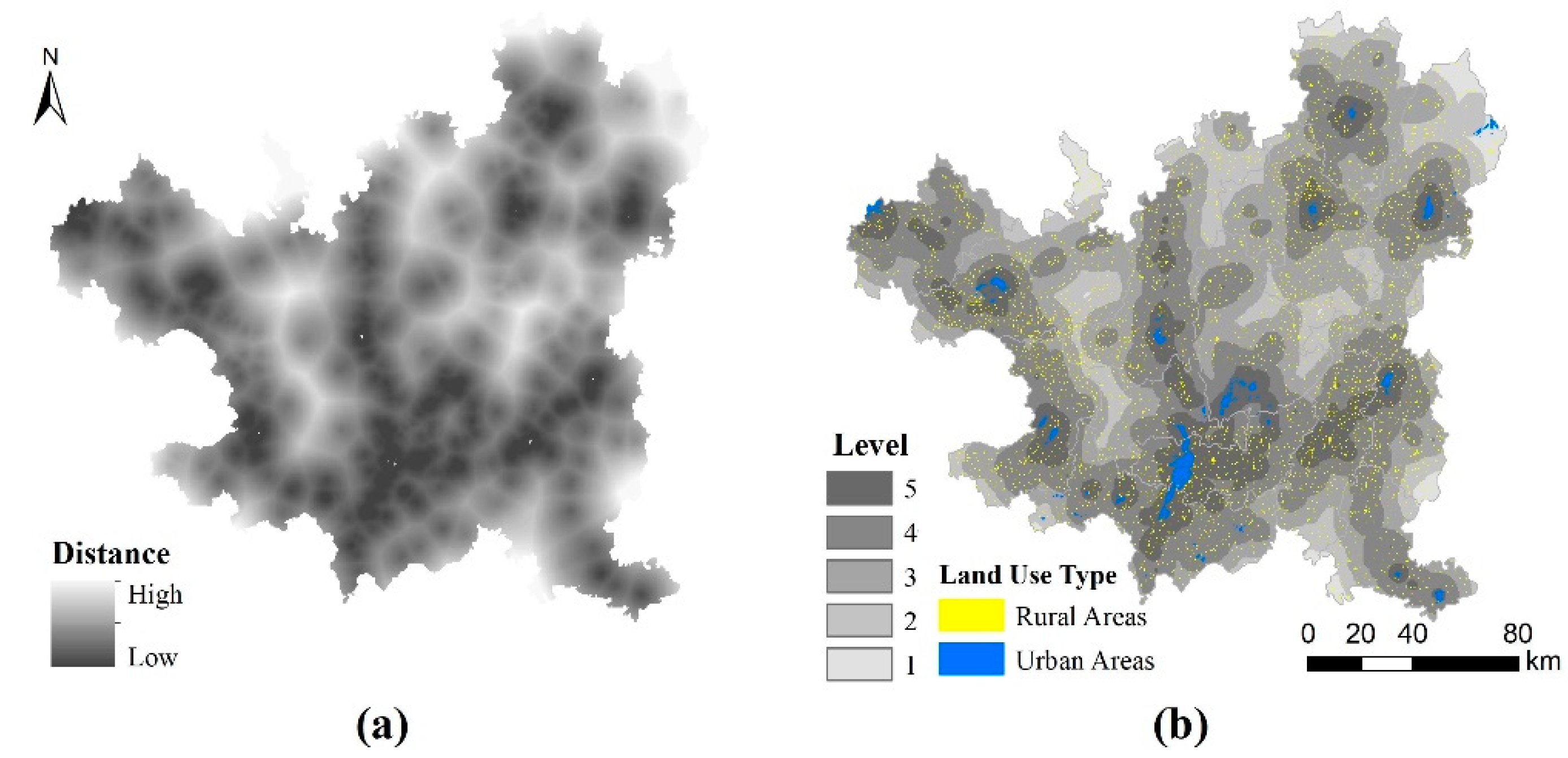
| Main Category | Subcategory | Basic Type | |||
|---|---|---|---|---|---|
| No. | P (%) | Subcategory Name (No. of Basic Types) | Types | ||
| Natural tourism resources | A. Geographical Landscape | 142 | 17.66 | AA. Comprehensive natural tourist destination (50) | 24/37 |
| AB. Sedimentary and tectonic (3) | |||||
| AC. Geomorphic processes (79) | |||||
| AD. Natural Changes (10) | |||||
| B. Water Landscape | 67 | 8.33 | BA. Rivers (18) | 9/15 | |
| BB. Natural wetlands and marshes (30) | |||||
| BC. Waterfalls (13) | |||||
| BD. Springs (6) | |||||
| C. Ecological Landscape | 39 | 4.85 | CA. Woodland (17) | 8/11 | |
| CC. Flowered areas (14) | |||||
| CD. Wildlife habitat (8) | |||||
| D. Astronomical and Climate Landscape | 11 | 1.37 | DA. Light phenomena (4) | 5/8 | |
| DB. Weather and climate phenomena (7) | |||||
| Subtotal | 259 | 32.21 | 13 | 46/71 | |
| Manmade and cultural tourism resources | E. Heritage sites | 148 | 18.41 | EA. Prehistoric site (6) | 7/12 |
| EB. Cultural and economic monument (142) | |||||
| F. Architecture and infrastructure | 367 | 45.65 | FA. Comprehensive cultural tourism destinations (97) | 35/49 | |
| FB. Dedicated activity sites (36) | |||||
| FC. Landscape architecture and attached buildings (160) | |||||
| FD. Residential areas and communities (50) | |||||
| FE. Burial grounds (16) | |||||
| FF. Transportation architecture (3) | |||||
| FG. Hydraulic structures (5) | |||||
| G. Tourism products | 17 | 2.11 | GA. Local tourism products (17) | 2/7 | |
| H. Cultural Activities | 13 | 1.62 | HA. Memorials (2) | 6/16 | |
| HB. Art (1) | |||||
| HC. Folk customs (5) | |||||
| HD. Modern festivals (5) | |||||
| Subtotal | 545 | 67.79 | 14 | 50/84 | |
| Grand total | 804 | 100 | 26/31 (83.87%) | 96/155 (61.94%) | |
| Evaluation Item | Evaluation Factor | Score | Levels |
|---|---|---|---|
| Resource element value | Sightseeing & recreation value | 30 | 30-22; 21-13; 12-6; 5-1 |
| Historical, cultural, science and Artistic value | 25 | 25-20; 19-13; 12-6; 5-1 | |
| Rare & singularity | 15 | 15-13; 12-9; 8-4; 3-1 | |
| Scale, abundance and probability | 10 | 10-8; 7-5; 4-3; 2-1 | |
| Integrity | 5 | 5-4; 3; 2; 1 | |
| Visibility & influence | 10 | 10-8; 7-5; 4-3; 2-1 | |
| Resource influence | Appropriate tour period or using range | 5 | 5-4; 3; 2; 1 |
| Added value | Environmental protection & environmental safety | −/+ | -5; -4; -3; 3 |
| THI (°C) | Category | WEI |
|---|---|---|
| −1.7~13.0 | Cold | −800~−600 |
| 13.0~14.0 | Cool | −600~−300 |
| 15.0~20.0 | Comfortable | −300~−200 |
| 20.0~26.5 | Warm | −200~−50 |
| 26.5~29.9 | Hot | −50~80 |
© 2018 by the authors. Licensee MDPI, Basel, Switzerland. This article is an open access article distributed under the terms and conditions of the Creative Commons Attribution (CC BY) license (http://creativecommons.org/licenses/by/4.0/).
Share and Cite
Jiang, H.; Yang, Y.; Bai, Y. Evaluation of All-for-One Tourism in Mountain Areas Using Multi-Source Data. Sustainability 2018, 10, 4065. https://doi.org/10.3390/su10114065
Jiang H, Yang Y, Bai Y. Evaluation of All-for-One Tourism in Mountain Areas Using Multi-Source Data. Sustainability. 2018; 10(11):4065. https://doi.org/10.3390/su10114065
Chicago/Turabian StyleJiang, Hou, Yaping Yang, and Yongqing Bai. 2018. "Evaluation of All-for-One Tourism in Mountain Areas Using Multi-Source Data" Sustainability 10, no. 11: 4065. https://doi.org/10.3390/su10114065
APA StyleJiang, H., Yang, Y., & Bai, Y. (2018). Evaluation of All-for-One Tourism in Mountain Areas Using Multi-Source Data. Sustainability, 10(11), 4065. https://doi.org/10.3390/su10114065






